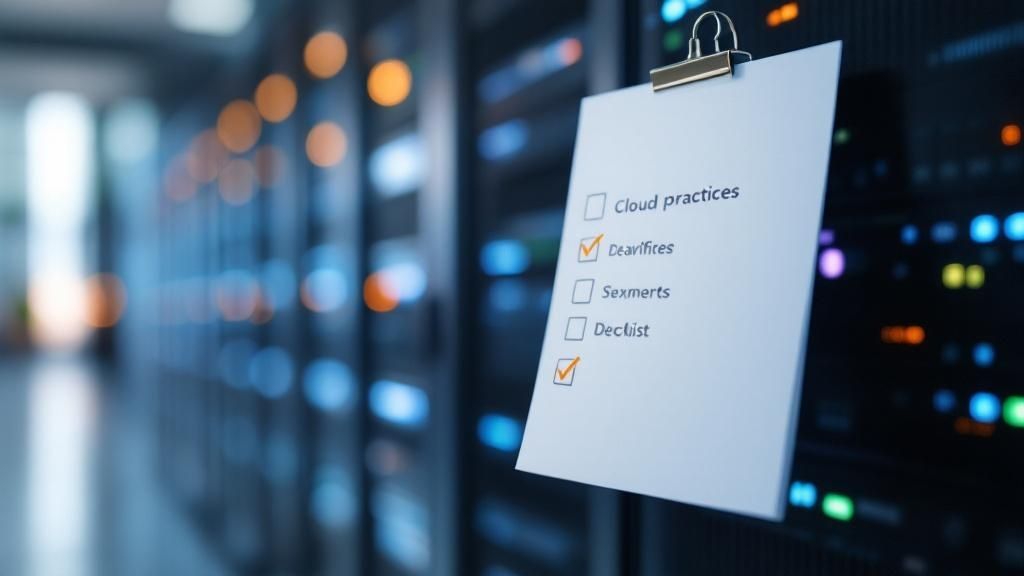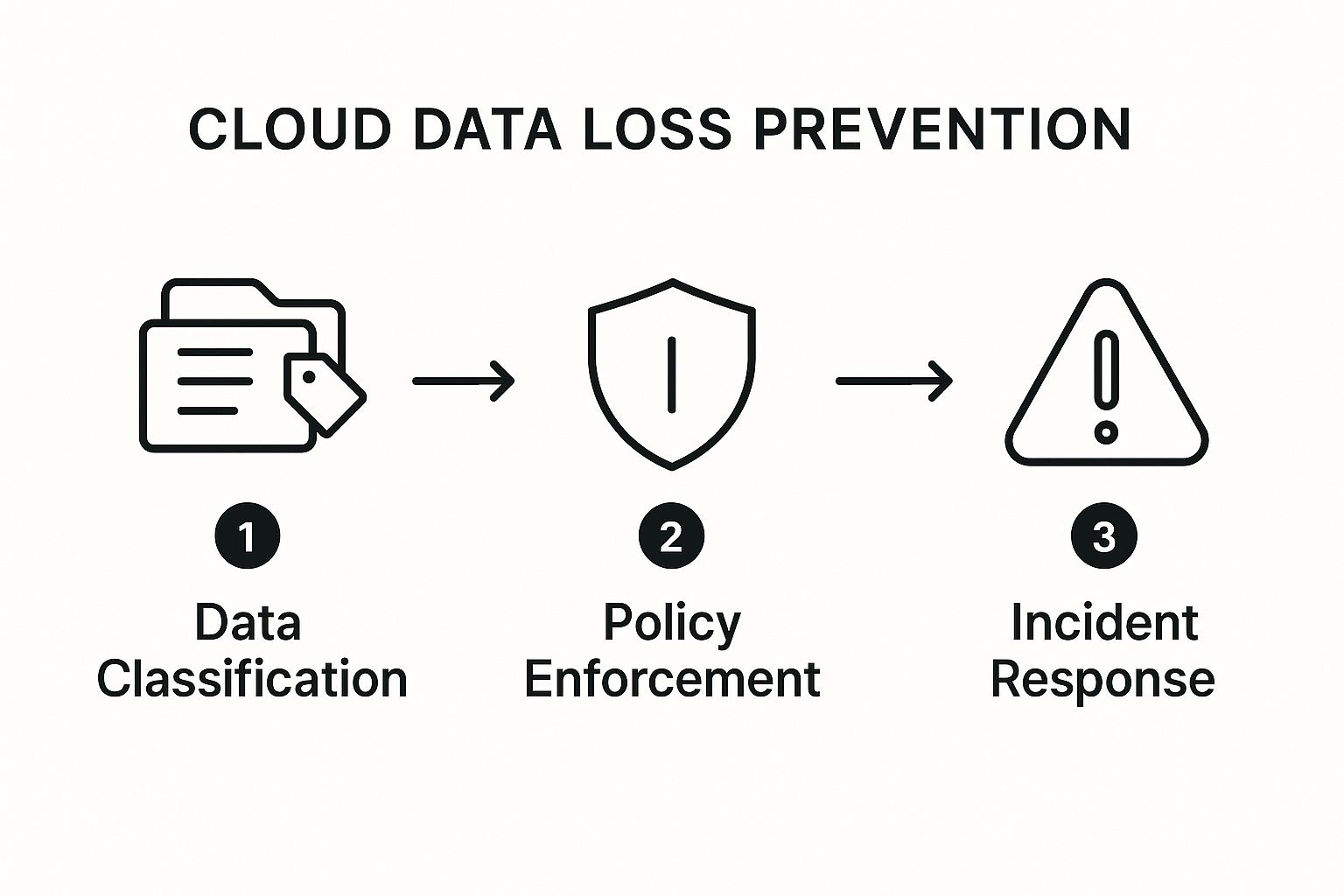Physical Address
304 North Cardinal St.
Dorchester Center, MA 02124
Physical Address
304 North Cardinal St.
Dorchester Center, MA 02124

A practical guide to cloud data loss prevention (DLP). Learn how to protect your business with a robust strategy for securing sensitive data in the cloud.
Think of a security guard who never sleeps, constantly watching every single piece of information your company keeps in the cloud. In a nutshell, that's cloud data loss prevention (DLP). It’s a complete strategy, blending smart technology with clear processes, all designed to stop your sensitive data from being lost, leaked, or misused in a cloud environment.
Remember when all your company's data was stored in a server room down the hall? Securing that on-premise "vault" was relatively straightforward. Now, with cloud services, it's like your most valuable assets are spread across multiple, highly accessible vaults all over the world. While incredibly convenient, this new setup introduces a whole new set of risks.
Cloud DLP is the advanced security system built for these modern vaults. Its job is to figure out exactly what data you have, where it’s stored, and who’s touching it. From there, it enforces rules to prevent things from going wrong. This isn’t just about stopping hackers; it's about catching common human mistakes, like an employee accidentally emailing a confidential client list to the wrong person or misconfiguring a cloud storage folder and leaving it wide open to the public.
A rock-solid cloud DLP strategy is built on a few fundamental pillars. Each one plays a unique role in creating a protective shield around your digital information. For a deeper dive into the wider world of data security, you can read our complete guide on cloud data protection.
Taking this proactive approach is quickly becoming a non-negotiable part of doing business. The global market for cloud DLP was valued at roughly USD 3.2 billion in 2024 and is expected to surge to USD 18.6 billion by 2030, a clear sign that companies are taking security and regulatory pressures seriously. You can explore the full report from Data Horizzon Research to see the drivers behind this rapid adoption.
To give you a clearer picture of how it all works, let’s break down the essential components that make up a DLP framework.
The table below outlines these foundational pillars, explaining what each one does and giving a real-world example of it in action.
| Pillar | Function | Example Action |
|---|---|---|
| Data Discovery | Finding sensitive information across all cloud services. | Scanning cloud storage to locate files containing credit card numbers. |
| Data Classification | Categorizing data based on its sensitivity level. | Automatically tagging documents as "Confidential," "Internal," or "Public." |
| Policy Enforcement | Applying rules to control how data can be used or shared. | Blocking an attempt to upload a file marked "Confidential" to a personal cloud drive. |
| Monitoring & Response | Tracking data activity and alerting on potential violations. | Sending a security alert when unusual download activity is detected. |
When these four pillars work together, they create a comprehensive system that doesn't just react to problems—it actively prevents them from happening in the first place.

It’s easy to look at cloud data loss prevention (DLP) and see just another line item on the IT budget. That’s a serious mistake. In reality, it’s a non-negotiable investment in your business's survival. Without it, you’re essentially gambling with your finances, your reputation, and your ability to operate.
A data leak isn't just a temporary technical glitch. Imagine the fallout: crippling financial penalties from regulators like the California Consumer Privacy Act (CCPA) can stack up fast. At the same time, the trust you've built with customers erodes, causing long-term damage that’s incredibly hard to repair. A solid DLP strategy is your shield against these catastrophic outcomes.
The way we work has completely changed. With remote teams, bring-your-own-device (BYOD) policies, and a reliance on dozens of cloud apps, your sensitive data is spread thinner and is more exposed than ever before. This distributed setup creates countless new ways for data to leak out.
Often, these leaks aren't even malicious. An employee might accidentally create a public sharing link for a folder full of sensitive financial reports. In another common slip-up, a team member might use an unapproved piece of software or misconfigure a cloud storage bucket, unknowingly leaving a door wide open for anyone to walk through.
The scale of this problem is staggering. A recent IBM breach report found that an astonishing 82% of data incidents involved information stored in the cloud. This statistic is especially sobering for businesses in tech-forward regions like California, hammering home the urgent need for strong, cloud-native security. You can find more details in the comprehensive market analysis from Mordor Intelligence.
The data tells a clear story: if your information lives in the cloud, it's a prime target.
It’s time to shift your perspective on cloud DLP. Stop seeing it as a cost and start recognising it for what it is: an enabler of modern, secure business. It gives you the confidence to use powerful cloud tools without exposing your organization to unacceptable risks.
Ultimately, a good DLP strategy ensures you stay compliant, protects your intellectual property, and preserves the customer trust your brand is built on. This protection is a core part of business resilience. You have insurance for your physical assets, right? Think of a DLP strategy, paired with a reliable backup plan, as the insurance for your digital ones.
If you're looking for other ways to safeguard your operations, our article on cloud backup for small business offers more valuable insights. A proactive approach to cloud data loss prevention isn't just about dodging fines; it’s about securing your company's future.

When you hear about data loss, it’s easy to picture a sophisticated hacker orchestrating a dramatic cyberattack. While that threat is absolutely real, the day-to-day reality is often much quieter. Most data leaks don't start with a bang, but with a simple, unintentional mistake.
Effective cloud data loss prevention is just as much about guarding against these subtle, everyday human errors as it is about fending off external attacks. Many leaks begin with a single, seemingly harmless action, like an employee trying to be helpful by creating a public sharing link for a sensitive internal report, not realizing it makes the document visible to anyone online who finds it.
Another all-too-common scenario involves using personal cloud storage for work files. Picture a team member saving a client database to their personal drive to work on it over the weekend. Their intentions are good, but that one action moves critical data outside the company's secure environment, creating a huge security blind spot.
One of the biggest culprits behind cloud data leaks is misconfigured cloud storage. With the complexity of modern cloud platforms, it's dangerously easy to set up a storage bucket or database with the wrong permissions, accidentally leaving it wide open to the public. The numbers are shocking: research shows that a staggering 81% of organizations experienced at least one cloud security incident in the past year, with misconfigurations being a primary cause.
Even more concerning, around 21% of organizations have at least one public-facing cloud storage bucket that contains sensitive data. If you’re curious, you can explore more of these cloud security statistics from TechMagic's report.
Beyond storage settings, the rise of "shadow IT" creates another major risk. This is what happens when employees use unapproved third-party apps to do their jobs. These tools often connect to your core cloud services, but because they haven't been vetted by your security team, they create hidden backdoors for data to slip out of your control.
A data leak doesn't have to be malicious to be costly. A simple mistake, like attaching the wrong file to an email or pasting confidential data into a public web forum, can have severe consequences for your organization.
Today, most businesses don't just use one cloud provider. They rely on a mix of services—maybe AWS for infrastructure, Google Workspace for collaboration, and Salesforce for customer management. This multi-cloud setup brings a ton of flexibility, but it also introduces a lot of complexity, since every platform has its own unique security settings and potential weak spots.
Trying to manage security consistently across all these different services is a massive headache. A policy that’s perfectly enforced in one system might be completely missed in another, creating gaps that can be easily exploited.
This is exactly why a centralized cloud data loss prevention strategy that covers your entire digital footprint is so critical. It's also vital to make sure every step in your workflow is secure and standardized, including practices for encrypted document sharing. Without a single, unified view, you’re only protecting parts of your fortress while leaving other gates wide open.

Choosing a solution for cloud data loss prevention isn't a one-size-fits-all decision. The right tool should act like a highly intelligent inventory system for your company's most valuable digital information, keeping everything meticulously catalogued, tracked, and protected. But not all DLP platforms are created equal.
A modern solution has to start with comprehensive data discovery and classification. Think of it as the first step in organizing a massive library. The system needs to scan all your cloud environments—from Google Workspace to AWS—to actually find your sensitive data. Then, it must automatically tag it with labels like "Confidential," "PII," or "Internal Use Only." You can't protect what you can't see, making this initial step absolutely fundamental.
Once your "books" are on the shelves with the right labels, you need rules for who can check them out. This is policy enforcement. An effective DLP tool lets you build and apply granular rules that dictate how data is used, moved, and shared. For instance, you could create a policy that blocks any file tagged "Confidential" from being attached to an external email or uploaded to an unsanctioned app. Simple, powerful control.
But real protection goes far beyond a static rulebook. The best DLP solutions now bring in advanced capabilities like User and Entity Behaviour Analytics (UEBA). This technology doesn’t just follow rules; it learns what "normal" activity looks like for every user and then flags deviations that could signal a brewing threat.
UEBA is like having a security guard who not only checks IDs at the door but also notices when a regular employee suddenly tries to access the executive files or starts photocopying hundreds of documents at 3 a.m. It spots suspicious behaviour that a simple rule would completely miss.
This analytical power elevates your DLP from a simple gatekeeper to a smart, proactive monitoring system. It can, for example, detect if an employee’s account suddenly starts downloading an unusually massive volume of files—a classic sign of a data theft attempt or a compromised account.
As you compare different solutions, it’s crucial to understand the difference between foundational features and the advanced capabilities that handle modern, sophisticated threats. Some features are table stakes, while others are what truly separate a basic tool from an enterprise-grade security partner.
Here’s a look at how these features stack up:
| Feature | Description | Best For |
|---|---|---|
| Data Discovery & Classification | Automatically scans cloud storage to find and tag sensitive data (e.g., PII, financial info) based on patterns and keywords. | Essential: All organizations. This is the foundational first step for any DLP strategy. |
| Policy Enforcement | Allows admins to create and enforce rules to control data actions, such as blocking, quarantining, or encrypting files. | Essential: Organizations needing to control data movement and prevent accidental or malicious leaks. |
| Real-Time Monitoring & Alerts | Provides a live view of data activity and sends instant alerts when a policy violation or suspicious event occurs. | Essential: Security teams that need to respond to threats immediately before significant damage occurs. |
| User & Entity Behaviour Analytics (UEBA) | Uses machine learning to baseline normal user behaviour and detect anomalies that could indicate a threat (e.g., insider threat, compromised account). | Advanced: Organizations with complex environments or those concerned with sophisticated insider threats and account takeovers. |
| Optical Character Recognition (OCR) | Scans images, screenshots, and PDFs to find and classify sensitive text hidden within them. | Advanced: Companies in regulated industries like healthcare or legal that handle scanned documents and image-based records. |
| Forensic Audit Trails | Captures detailed, immutable logs of all data activity, providing a complete record for incident investigation and compliance audits. | Advanced: Businesses that must meet strict compliance standards (e.g., HIPAA, GDPR, PCI-DSS) and need to prove due diligence. |
This comparison makes it clear that while basic discovery and policy enforcement are must-haves, advanced features like UEBA and OCR are what give you the power to see and stop threats that would otherwise fly under the radar.
Ultimately, a top-tier cloud data loss prevention tool gives you deep visibility from a single dashboard, intelligent automation that does the heavy lifting, and alerts that are actually actionable. For businesses that rely heavily on collaboration, built-in controls for things like secure file sharing are also non-negotiable. It should empower your security team to stop real threats fast, without drowning them in a sea of false positives.
Rolling out a successful cloud data loss prevention program can feel like a huge undertaking. The trick is to stop thinking of it as one massive project and instead break it down into logical, manageable stages. Don't try to solve every problem at once. A phased approach lets you protect your most critical data first, score some early wins, and build momentum from there.
The best place to start is by getting leadership on your side. You have to frame the initiative not as another IT expense, but as an essential safeguard for the business—one that protects revenue, reputation, and your most valuable intellectual property. Set clear, realistic goals for what you want to achieve in the first phase, focusing on high-risk areas like customer financial data or preventing trade secrets from being shared accidentally.
Let’s be honest: you can’t protect what you don’t know you have. That’s why the foundational first step is always comprehensive data discovery. Your goal here is to get a complete map of where all your sensitive information lives across your entire cloud footprint, from collaboration hubs like Google Workspace to storage buckets like Amazon S3.
Once you have that visibility, you can move on to data classification. This is where you start labelling your data based on how sensitive it is. Think of it like putting security tags on your digital files:
This classification process isn't just busywork; it's the bedrock of your entire DLP strategy. Every single policy you create will be built on it.
With your data neatly classified, you can finally start building the rules that will enforce your policy enforcement. Start simple with policies that deliver high impact. For instance, a great starting rule is one that blocks any file tagged as "Restricted" from being shared with an external email address. Another might be a policy that sends an alert to your security team whenever an unusually large number of "Confidential" files are downloaded by a single user.
Before you unleash these policies on the whole company, it's absolutely critical to run a pilot test with a small, controlled group of users. This gives you a chance to fine-tune your rules, catch any configurations that might mess up legitimate workflows, and gather real-world feedback.
A pilot program is your safety net. It helps you find and fix problems on a small scale, preventing widespread chaos and ensuring your full rollout goes smoothly. By testing first, you demonstrate early wins and build confidence in the program across the whole organisation.
This infographic breaks down the core workflow of a cloud DLP implementation, from the initial discovery of your data all the way to responding to potential threats.

As the visual shows, a strong cloud data loss prevention strategy isn't a one-and-done project. It's a continuous cycle: you classify your data, enforce protective policies, respond to incidents, and then use what you've learned to refine your classifications and rules all over again.
When your business expands globally, your data risks follow. Crafting a successful international keyword strategy involves more than just translating your website; it requires a robust cloud data loss prevention framework that can navigate different borders, languages, and complex regulations.
As soon as you create multilingual content or geo-targeted landing pages, your security challenges escalate. That localized content for your German audience is subject to GDPR, while your marketing campaign in Japan must comply with APPI. Without a unified security strategy, your global growth could become a global data breach.
A centralized DLP strategy is crucial. It ensures every piece of localized content, from a product description in Canadian French to a technical document in Korean, adheres to core security policies. This protects your sensitive data no matter where it is created, stored, or viewed, making DLP a critical component of your international SEO efforts.
A strong international strategy relies on technical SEO for visibility in different regions. This means building localized content on geo-targeted landing pages that must be both search-engine-friendly and secure. Your cloud DLP solution must support these goals, not hinder them.
For instance, a DLP policy can automatically scan a new geo-targeted page before publication, checking to ensure no personally identifiable information from a regional customer list was accidentally included. This simple check prevents compliance issues without slowing down your content marketing pipeline. Many companies use tools like document generation software for efficiency, and the output from these tools must also be scanned by your DLP to ensure security.
View your DLP strategy as an enabler for global expansion. It establishes the guardrails that allow your marketing and content teams to create compelling localized experiences confidently, knowing they are not exposing the company to risk. This is the difference between expanding safely and expanding recklessly.
Building a strong backlink profile in target regions is key for authority and driving global conversions. However, this outreach involves sharing content with regional partners and media, creating more potential exit points for your data.
A smart DLP solution helps manage this risk by:
By integrating DLP into your global workflow, you can build trust in new markets and boost conversions without compromising security. For small businesses entering international markets, getting these fundamentals right is vital. Learn more about building a secure foundation in our guide to cloud storage for small business. This approach ensures your global content strategy is both secure and effective.
If you're still wrapping your head around cloud DLP, you're not alone. Let's clear up a few of the most common questions that pop up when organizations start thinking seriously about protecting their data.
Think of it this way: traditional on-premise DLP is like a security guard stationed at the single front door of your office building. It’s great at monitoring that one entry and exit point.
But today, your "office" is a sprawling campus with hundreds of doors and windows—apps like Google Workspace, AWS, and Slack. Modern cloud DLP is the security team that monitors every single one of those access points, giving you visibility and control over data no matter where it's heading. On-premise tools just weren't built for that kind of environment.
The best first step is always data discovery. You don’t have to manually hunt through every file and folder. A good DLP solution automates this process entirely.
It scans all your cloud platforms, proactively flagging information that looks like credit card numbers, personal IDs, or valuable intellectual property. The tool does the heavy lifting, creating a clear map of your most important digital assets so you know exactly what you need to protect.
No single tool can ever guarantee 100% prevention, and it’s important to be realistic about that. A powerful cloud DLP strategy is about dramatically reducing your risk.
Its primary job is to stop the common, accidental leaks that happen every day and to flag suspicious activity that might signal a more malicious attack. This gives your security team the critical information they need to step in and act fast.
A robust cloud DLP strategy acts as your best and most reliable line of defence against both simple mistakes from inside your team and determined threats from the outside.
Ready to secure your cloud data with powerful, easy-to-use tools? Sky Drive Folder offers AES-256 encryption, password-protected sharing, and full control over your files to create a secure environment for your most important information. Discover a smarter way to manage and protect your digital assets at https://skydrivefolder.com.